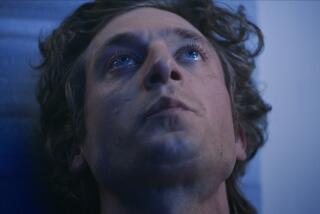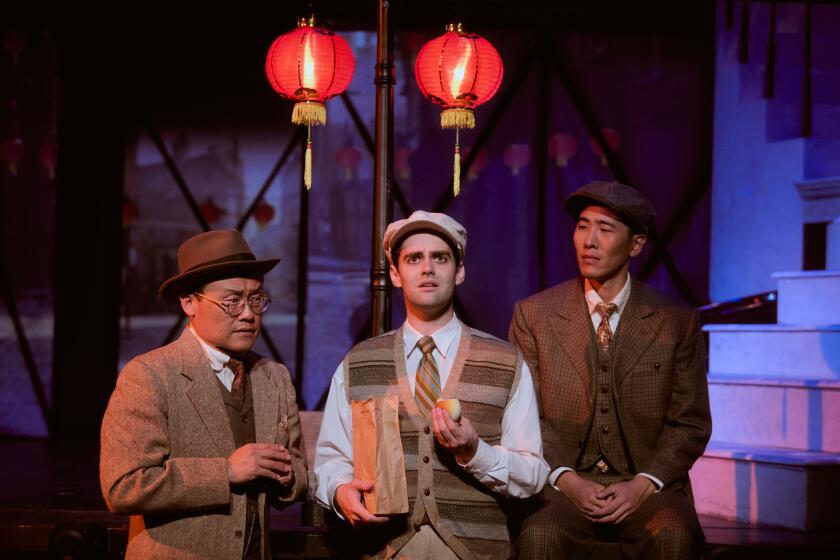ART REVIEW : LACE’s ‘Self-Evidence’ Exhibit Takes Viewer for a Spin
So who are you, anyway?
Who would you like me to be?
Well, just yourself.
That depends on your expectations and my frame of mind.
Dreamy, discursive, opaque, strident, allusive--the various selves that artists conjure up in “Self-Evidence” at Los Angeles Contemporary Exhibitions (to June 11) tend to treat the viewer as the “straight man” while they dance rings around him.
Deftly assembled by Larry Rinder, assistant curator at the University Art Museum, UC Berkeley, the show includes work in disparate media by artists from California, New York and points between. They describe themselves with reference to the look of their bodies, their sexual orientation, their mortality, their fears--or simply their undeniably subjective view of the world.
As Rinder writes in the forward to the catalogue, the exhibit is meant to evoke “a pair of ideas that don’t quite get along.” One is that a human personality can only be known by looking for its impact on language and culture. The other is that the self is an elusive will-o’-the-wisp whose presence is somehow “beyond rational argument.” Although most of the pieces in the show are fairly straightforward, they are all deliberately open-ended, posing riddles with no easy answers.
Dorit Cypis asked four artists to photograph her in the nude. The resulting sets of portraits range from rather stiff poses-for-the-public in bright light (by Linda Brooks) to shadowy images suggestive of privacy and pleasure (by Nan Goldin). The viewer begins to wonder if these images may have more to do with photographers’ notions of the role of nude photography than the identity of the sitter.
Gretchen Bender superimposed the words “I’m going to die” on a TV screen, effectively filtering all the tube’s images through a fixed, tragic perspective that is at once intensely personal (particularly if death is perceived as untimely) and utterly impersonal (everyone is going to die, someday).
Tim Hawkinson’s uncanny ability to turn the stuff of daily life inside out is reflected in “Electrocardiogram Landscape,” a pattern of tall and short pine trees that form a vista disguising what appears to be an actual electrocardiogram.
Some of the most subversively intriguing pieces are part of a project led by the pseudonymous “Anne Castle” that involved the participation of several artists hiding behind fake names.
One of these people is “Jane McElneny,” (just to make things more confusing, this is actually “Anne Castle” under another name) whose “Soulograms” are simply sheets of gleaming black photo paper labeled “Elation,” “Despair,” “Angst” and “Lubricity” that await the viewer’s self-projection.
Another participant is “I. Eberhardt,” whose “Transit-War” consists of a long text and a bodiless ghost of a figure created on the wall with a head made out of a big turtle shell, a pair of decrepit black gloves, and a couple of beat-up old boots.
The text deals ambiguously with the theme of self-preservation and identity. As a child, the artist delighted in a turtle that was later killed by another animal. An adult friendship with a street person to whom the clothing once belonged ended when the man was beaten to death. But the artist then began wearing the drifter’s clothing.
“I knew I was safe because no one could see me,” Eberhardt comments. A raft of ideas swirl around this piece, among them the notion that one person’s greatest vulnerability may be another person’s protective coloring--and that, in the end, not even a hard shell protects a creature forever.
Other work is more stringently conceptual in approach.
Pauline Stella Sanchez’s “The Gray Scale” is a set of five panels, each painted--in a brushy, free style--in a different shade of gray, and each ornamented on the upper right-hand side with two tiny gold stars.
The piece--suggested by an art education exercise--creates a solipsistic universe in which the artist is also the judge. She awards gold stars to herself for a project that (as she explains in the catalogue) really cannot be properly evaluated, because of the idiosyncratic way she applied the paint and the fact that neither polarity of the gray scale (black or white) is represented.
And finally, there are pieces that frankly try the patience of the viewer seeking at least to understand the question, if not to grasp the answers.
Millie Wilson’s “Los Angeles Times Series”--constellations of paintings based on the way photographs of women from The Times’ news and sports sections have been selected, cropped and arranged on the page--comes across as stringently programmatic but devoid of sufficient information to make a cogent point.
The details that Wilson isolates--the muscle in an arm, an open mouth, hugging bodies in pants--are evidently meant to illustrate subjectivity on the part of photographers and the people who dummy up the page formats. But in the absence of a “control group” (other newspapers, male subjects, other photographs of these people), the issue lacks focus.
The show’s catalogue also contains pieces by several writers prominent in avant-garde circles, including Carla Harryman, Frank Chin, Donald Britton and Diane Ward. They will give a free reading at LACE June 11 at 3 p.m.
More to Read
The biggest entertainment stories
Get our big stories about Hollywood, film, television, music, arts, culture and more right in your inbox as soon as they publish.
You may occasionally receive promotional content from the Los Angeles Times.






